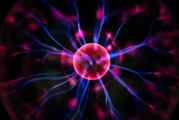They're Calling Everything 'Plasma' Now, and It's Just as Confusing as You'...
2025-10-02 13 Plasma
The Sub-$1 Hydrogen Promise: Deconstructing the AI-Driven Breakthrough
The energy sector is littered with the ghosts of “game-changing” technologies that promised to rewrite our future. We’re told, with breathless enthusiasm, that we’re just one breakthrough away from a clean energy utopia. So when a study lands in a prestigious journal like Nature Chemical Engineering touting a path to hydrogen at less than one dollar per kilogram, my default position is skepticism. The US$1/kg target is the holy grail—a price point that could fundamentally reshape transportation, industry, and power generation.
The paper, Interpretable machine learning-guided plasma catalysis for hydrogen production, from a team led by Saleh Ahmat Ibrahim and Shengyan Meng, doesn't propose some exotic new physics. Instead, it details a far more interesting development: a brute-force, data-driven solution to a stubborn chemistry problem. They're using machine learning to crack the code of ammonia decomposition, and their results, at least on paper, are compelling. My job isn't to celebrate the headline but to scrutinize the data. Let’s look at the numbers and see if this breakthrough holds up.
The core of the challenge has always been the catalyst. To produce hydrogen from ammonia (NH3) efficiently, you need a material that can convince the nitrogen and hydrogen atoms to part ways without demanding a colossal amount of energy. For years, the process has been a bit of a guessing game, involving expensive and rare metals. The best catalyst for conventional heating is Ruthenium; for the plasma method, it’s been Cobalt. Both have significant cost and supply chain issues.
This is where the new research pivots. Instead of relying on intuition and iterative lab work, the researchers turned the problem over to a machine learning model. The process is like giving a master locksmith a supercomputer to design the perfect key. The lock is the nitrogen atom in ammonia, and the key is the catalyst. The ML model’s only instruction was to find a key that fit with a precise amount of binding energy—an ideal target of -0.51 electron volts (eV). The model then churned through the atomic structures of over 3,300 potential alloys, a task that would be impossible to perform physically.
What it spat out was not a single "magic" element but a series of boring, practical, and, most importantly, cheap alloys: Fe3Cu (iron-copper), Ni3Mo (nickel-molybdenum), and others composed of earth-abundant metals. This is the first data point that gets my attention. Shifting the material dependency from something like Ruthenium to common industrial metals like iron and nickel isn't just an incremental improvement; it’s a foundational change to the entire economic equation. And this is the part of the report that I find genuinely compelling. I've looked at hundreds of these techno-economic models, and the assumptions baked into the input costs for raw materials are always the first place I check for weaknesses. Starting with cheap, abundant metals is a fundamentally sound position.
But a simulation is just that—a simulation. The real question is whether these digitally-optimized keys can actually unlock the door in the physical world.

The researchers took their AI-generated candidates from the screen to the lab. Using a nonthermal plasma reactor (essentially, an ionized gas that allows for reactions at lower temperatures), they tested the new alloys. The experiments, run at a modest 400°C, confirmed the model's predictions. The Ni3Mo alloy, in particular, achieved ammonia conversion rates comparable to Cobalt, the existing benchmark.
This is where the headline-grabbing numbers come from. Their techno-economic analysis, based on these experimental results, projects a final hydrogen production cost below the US$1/kg target. The process is projected to have a low carbon footprint, around 0.9 kg of CO2—to be more exact, 0.91 kg per kg of H2 produced. On the surface, it’s a complete victory. They used an algorithm to find a cheap material, proved it works in the lab, and ran a model showing it could make hydrogen production economically viable.
But here’s where a healthy dose of skepticism is required. Lab-scale techno-economic analyses are notoriously optimistic. They operate in a perfect world of stable input costs, 100% uptime, and zero-cost capital. What does their model assume for the price of electricity needed to generate the plasma in the first place? In a world of volatile energy prices, that single variable can shatter the entire sub-$1 projection. The paper is thin on these details.
Furthermore, how does this catalyst perform over thousands of hours of continuous operation? Catalyst degradation is a massive operational expense in chemical processing, yet it’s a variable often minimized in short-term academic studies. What is the true lifetime of an Fe3Cu catalyst inside the harsh environment of a plasma reactor, and what are the costs of replacing it at an industrial scale?
The 0.91 kg CO2 footprint is impressive, but is that a "well-to-wheel" calculation or just the emissions from the reactor itself? If the electricity powering the plasma comes from a natural gas plant, the "low-carbon" claim becomes significantly weaker. These aren't criticisms of the core scientific discovery, which is clearly significant. They are, however, the critical questions that separate a fascinating lab result from a viable, investable industrial process.
Let's be clear: the data presented in this study marks a legitimate and important step forward. The application of machine learning to screen for catalysts is the real revolution here. It’s a powerful new tool that will undoubtedly accelerate materials science across countless industries. They have successfully solved a critical variable in the hydrogen production equation.
But it’s just one variable.
The path to a sub-$1 hydrogen economy isn't a simple chemistry problem anymore. It's now a far more complex and expensive systems engineering and infrastructure challenge. This research provides a better, cheaper engine, but it doesn't build the car or the national highway system it needs to run on. The chasm between a successful lab experiment and a network of thousands of distributed, on-site hydrogen production facilities is measured in trillions of dollars and decades of work. This paper proves the what. It leaves the much harder questions of how and when unanswered.
Tags: Plasma
Related Articles

They're Calling Everything 'Plasma' Now, and It's Just as Confusing as You'...
2025-10-02 13 Plasma

The word “plasma” appeared in four distinct contexts in my feed over the la...
2025-10-01 19 Plasma